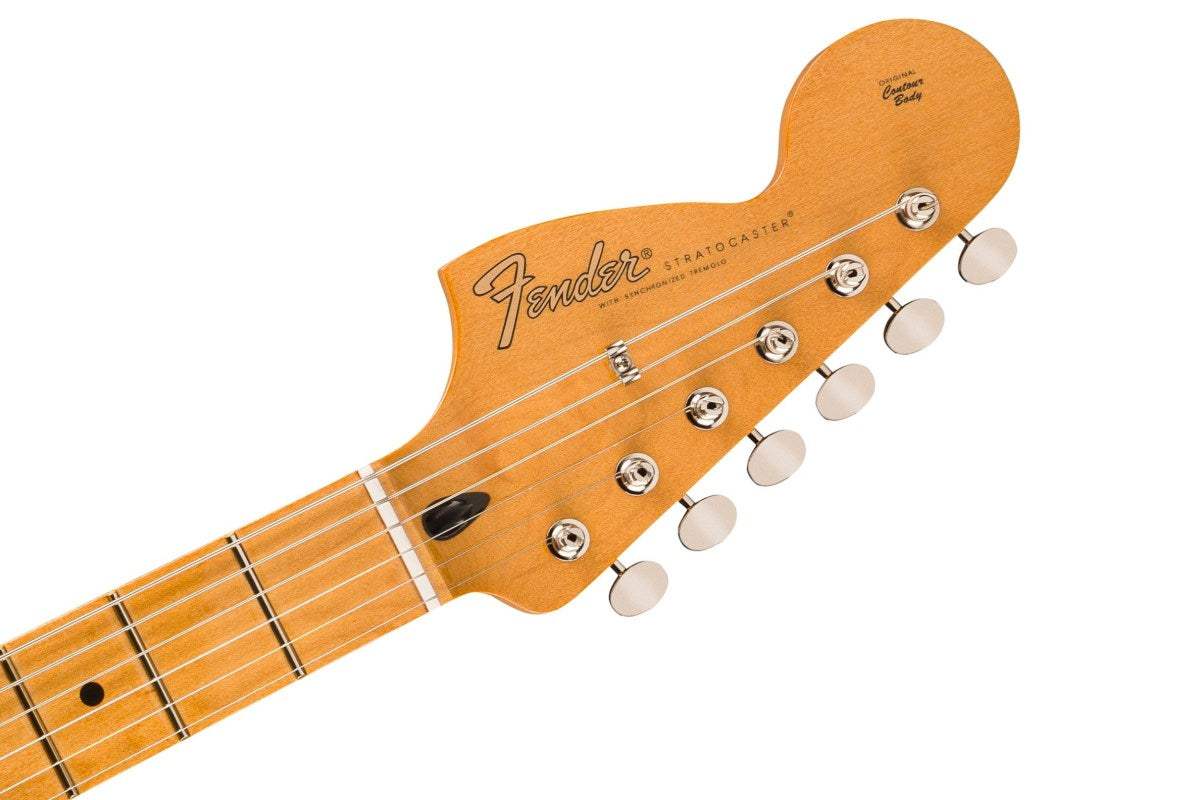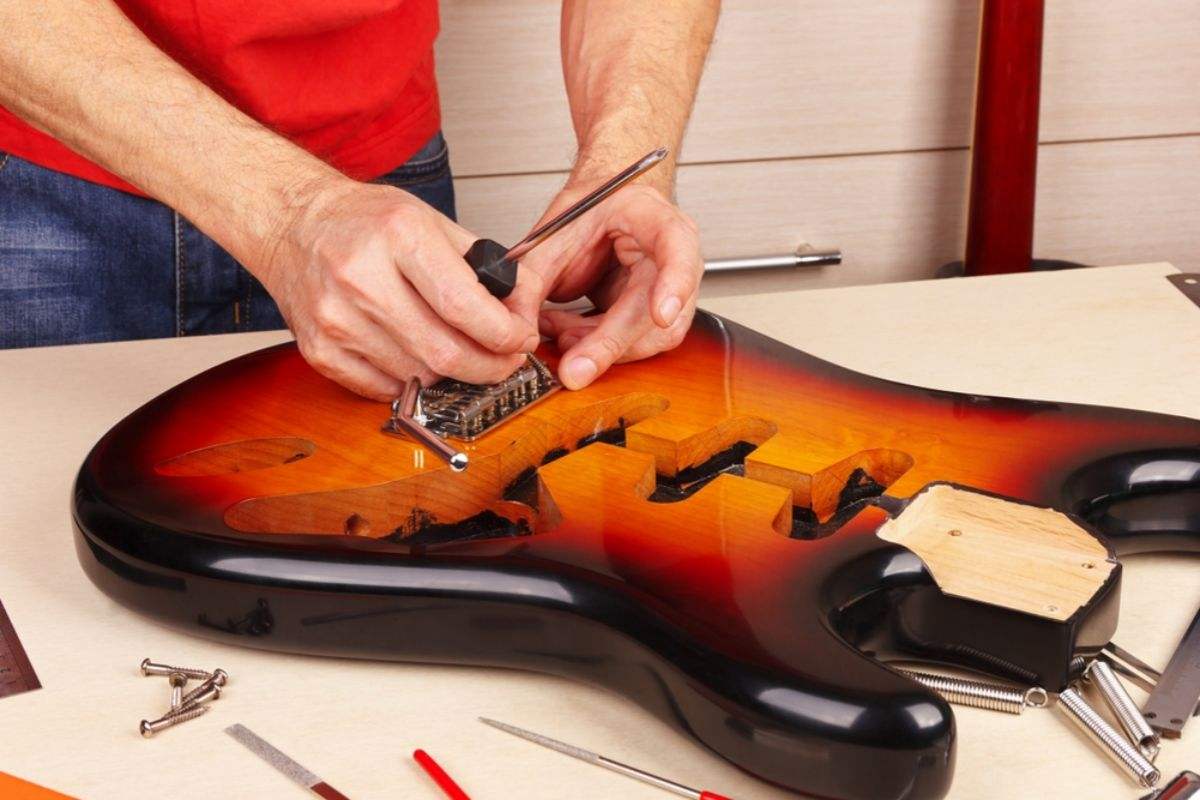Many guitarists and avid DIYers dream of building their very own guitar. The satisfaction of creating a playable, great sounding, and beautiful-looking instrument is immensely rewarding. However, one of the most common concerns is “How good will I get the finish, will it end up looking really cheap?”
Well, the answer is… if you don’t know what you’re doing, probably yes. But if you follow the processes, tips, and tricks I’m about to share with you, you should get a guitar finish that you can be proud of. Let’s start by finding out…
How do I get a Pro Finish on my DIY or Kit Guitar?
Keeping things simple, there are three ways that you can create a great-looking and durable finish on your guitar without the need for expensive equipment, buffing wheels, or fancy polishing.
- Oil finish (stained or unstained)
- Matt finish over a solid color/colors or stains
- High gloss finish over a solid color/colors
All you will need are the materials, some brushes (if you are using paint), thinners, and various grits of sandpaper. You’ll also need a lot of patience and a good deal of elbow grease to make up for the lack of expensive equipment.
How to Prepare the Surface of the Guitar
Regardless of which finish you have chosen, you will need to prepare the body properly. You need to make it as smooth as possible, for both playing comfort and looks. Therefore you will need to treat the grain and some heavy sanding.
Most guitar kits are sanded to around 100 grit, if you’re happy with how it has been sanded, i.e. it’s even across the whole body, then you can increase the grit to 220, 320, and then 400. Some luthiers sand up to around 600, for an ultra-smooth finish, but this really isn’t necessary for a DIY or kit guitar.
To Fill or Not to Fill
The pores and grain of wood give it beauty and character and you might want to enhance these for a certain look to your finish. However, depending on which wood you have chosen, the grain and pores might need to be filled to get you the smooth finish you are going for. Therefore, it depends on the desired finish and wood type to dictate if any filling is necessary before sanding.
Raising the Grain
There is a common woodworking trick that is often used on guitars to improve the effectiveness of sanding. Sand the body as normal, then get yourself a damp rag and wipe it all over the guitar's body. As the wood dries, the grain will ‘raise’ making it easier to get a smoother finish. Use the same grit of sandpaper you used before applying the damp rag, or a higher grit to get the silky smooth texture you want as well as fewer finishing problems later on if you apply a water-based finish.
How to Stain a Guitar
One of the easiest ways to achieve a pro finish on a DIY or Kit guitar is by using stains. Dyes and stains will enhance the natural texture of wood as well as adding color to it. The most simple method is to tint the entire surface with a single stain, or if you want something more ornate, create gradients such as the classic Gibson sunburst or the Fender 3-color bursts found on strats and teles.
Most stains and dyes are easily applied with a clean rag or lintless paper towels. But, if you’re new to this or trying a more complex multi-colored design, it’s well worth testing the stain on a similar piece of wood to see how it behaves and perfect your application process.
How to Get a Deeper more Complex Stain on a DIY or Kit Guitar
Lower grit sanding, for example between 240 and 400, will let the body absorb more of the stain giving it a deeper color. Surfaces that are sanded to a higher grit will absorb less stain creating a lighter color with less contrast.
If you want to really enhance the grain, stain the body with a darker color, even as dark as black, and then sand it down leaving the highlights, then add a lighter-colored stain or stains for the final finish.
How to Seal the Stain on Your Guitar
If you want a more hardwearing finish, it is well worth sealing your stain. Sealers not only protect the finish, but they also stabilize the stain ensuring it looks the way you want it to for years to come.
Oil or Stain?
If you don’t want a glossy shine, then go for an oil finish. It’s as easy to apply as stains with the first few layers getting absorbed into the wood bringing out its natural color. As you add more layers you will create a thicker finish that can then be polished to a beautiful silky sheen. It won’t give you the finish you’d get using lacquers but has its own distinctive look, as well as protecting your guitar from moisture and dirt.
How to apply an Oil Finish to a Kit or DIY Guitar
Start by applying a decent amount of oil because the majority of it will be absorbed by the body. Take a clean lint-less rag or a paper towel and massage the oil into the wood all over your guitar body. Work it in thoroughly before removing any excess oil with a cloth.
Then wait a few hours (up to a whole day) for it to be fully absorbed (dry to the touch) before applying a second (much thinner than the first) coat of oil. Repeat until you get the finish you are going for.
How to Apply a Solid Opaque Color
Personally, I am not a huge fan of stained or oiled guitars, I much prefer a good solid color. Solid colors are also excellent if the wood grain or pattern of your DIY or kit guitar isn’t visually appealing.
To get a solid, opaque color to look perfect, you will need to spend some extra time on the prep - grain filling and sanding - because any uneven surfaces will be enhanced by the flat color making the job look unprofessional. Also, filling the grain and any cracks or scratches at this stage is much easier than having to apply multiple layers of paint later on.
The easiest and smoothest way to achieve an even coat is by spraying. The best option is a spray gun, but if that’s outside your budget, then a good old spray can will have to do.
Spray cans obviously don’t give you the versatility and fine-tuning of a professional spray gun, but if you take your time, they can provide an excellent very affordable alternative. Plus, since they are often used on cars, motorbikes, etc. there are lots of visually interesting options available such as metallic finish, glitter finish, and various textures to really give your guitar a unique look.
How to Get a Good Finish on a Guitar Using a Spray Can
Start by thoroughly shaking the can, then…
- Holding it 10 to 15 inches away from the surface, spray a very small amount of paint at a slight angle
- After you find the perfect distance and angle, stay consistent and spray in a back-and-forth manner with a 50% overlap
- Apply a few more thin coats after about 15 minutes while the paint is still a little tacky.
- Leave it to thoroughly dry overnight
- If there are any inconsistencies in the finish, you can now very lightly sand the body (1200-1500 grit sandpaper), then add three more light coats leaving 15 minutes between each one
Take your time and be patient with all these steps, a quality finish can’t be rushed, especially if you are doing it all by hand.
Pro Tips for Spraying Your Guitar with a Can
- Put the spray can in warm water for a few minutes before you start
- Start spraying away from the guitar’s surface and work onto it
- Using less paint is far better than using too much
- Avoid runs by using less paint
- Avoid the nuzzle clogging (if this is an issue) by dipping it in hot water between layers
- If the nozzle does completely clog, clean it with a wet rag or remove and soak in naphtha, thinner, or mineral spirit.
How to Clear Coat Your Guitar
Clear coating is great for protection and a polished look and can be applied either with spray or manually. Spraying gives a thinner but more even coat, so you’ll need a number of layers. Manually applying it produces a much thicker coat quickly but the result will be less smooth.
Manual Clear Coat Application
The two most common methods are to use either Wipe-on or Brush-on polyurethane which is a bit thicker. The method is similar to the one I explained for Oil, apply a few layers with a brush or a rag to build up a thick coat.
It should be dry in around three hours, if not, wait a bit longer. Then add 2 or 3 more layers to build up the finish. If you’re happy with the thickness but the finish is uneven, sand it using 800 to 1000 grit sandpaper, before moving to 1200-1500 for the final fine sanding.
Sprayed Clear Coat Application
As with the color application I already explained, layer multiple coats to form a smooth, thick transparent surface that you can sand with high grit sanding paper. These coats can be applied about every 15 minutes, but if you need to sand between them, you will need to wait at least a day for the paint to dry.
Depending on the finish you want, you can apply 6 to 12 layers. The finish will be quite matt at this stage, if you want a more refined look you can polish it but you need to let the paint cure before you can do this which could take as long as a few weeks.
How to give your Kit or DIY Guitar a Glossy Finish
If this is the finish you’re after, you will need some severe elbow grease to polish and buff for a long time. If you’re up for the challenge, here are the steps:
Start sanding using 1200 or 1500-grit sandpaper to achieve a very smooth surface. Now check the surface from various angles to find any small uniform scratches. If there are larger scratches you may need to go back a few steps because you won’t be able to get rid of them at this stage.
Keep sanding to achieve a smooth finish, but be careful of going all the way through the clear coat. If you’ve done the prep work correctly, this shouldn’t be a problem, but it often is for beginners.
The smoother you layer your clear coats, the easier it is to sand, plus you can start with higher grit sandpapers, so getting your layering right will save you time and effort at this stage.
When you’re happy with an overall smooth finish using 1500 grit sandpaper, you can use 2000, 3000, 4000, or even 5000 grit.
How to Polish a DIY or Kit Guitar
Polishing is an abrasive action but on a microscopic level. You will need a polishing compound that contains lubricants, these usually come as a set of two or three - one for rougher, slightly deeper scratches, one for medium scratches, and one for very fine swirls.
Polishing compound is applied using pads that can be drill mounted, or you can use orbital sanders or designated polishers. Or, if you’re sticking to a tight budget, you can apply them by hand with a microfiber rag or a clean cotton cloth.
They are widely used in car restoration, and you can choose any product you like, just make sure it contains lubricants and is a polishing compound, not a wax.
Application
Start with the more aggressive compound, and rub it in a circular motion over the entire surface for a few minutes before removing the residue. Next, repeat the process with the finer compound using a new piece of cloth or pad. This is where the need for elbow grease comes in!
If your set contains a third, ultra-fine compound, get a new pad or rag and repeat again. If your final polish isn’t quite what you expected, repeat the process using the ultra-fine compound and a softer pad or cloth until you get the results you want.
Tips
If you’re polishing with a sander, drill, or furiously by hand, the finish can get relatively hot. If you notice this, leave the next polishing session a while until the finish cools down to protect the clear coat. If you’re set features a wool pad for final polishing, be especially careful because these can get very hot.
Apply the compound to the surface of the body with firm, consistent force, but don’t grind it in, it’s an abrasive and can easily damage the topcoat.
Keeping your surface moist by applying a little clean water using a spray bottle allows you to effortlessly polish as opposed to fighting the finish. But watch out for water and other residues going into cavities and screw holes, if this happens, dry them out with a cloth or a cotton bud.
Wrapping it Up
Applying the finish to your DIY or guitar kit can seem overwhelming, but hopefully, you are now a lot more confident about taking on the challenge. For more information, it’s well worth checking out a few YouTube videos for visual examples of the techniques I have discussed and even more tips and tricks.
The finishing process is a lot of fun, as well as allowing you to unleash your creative side to make a guitar that is truely unique.
Remember that you can achieve a professional-looking finish with basic tools, but it is a lot more work. So, forget going to the gym for your arm workouts for a week or so and get sanding and polishing!





